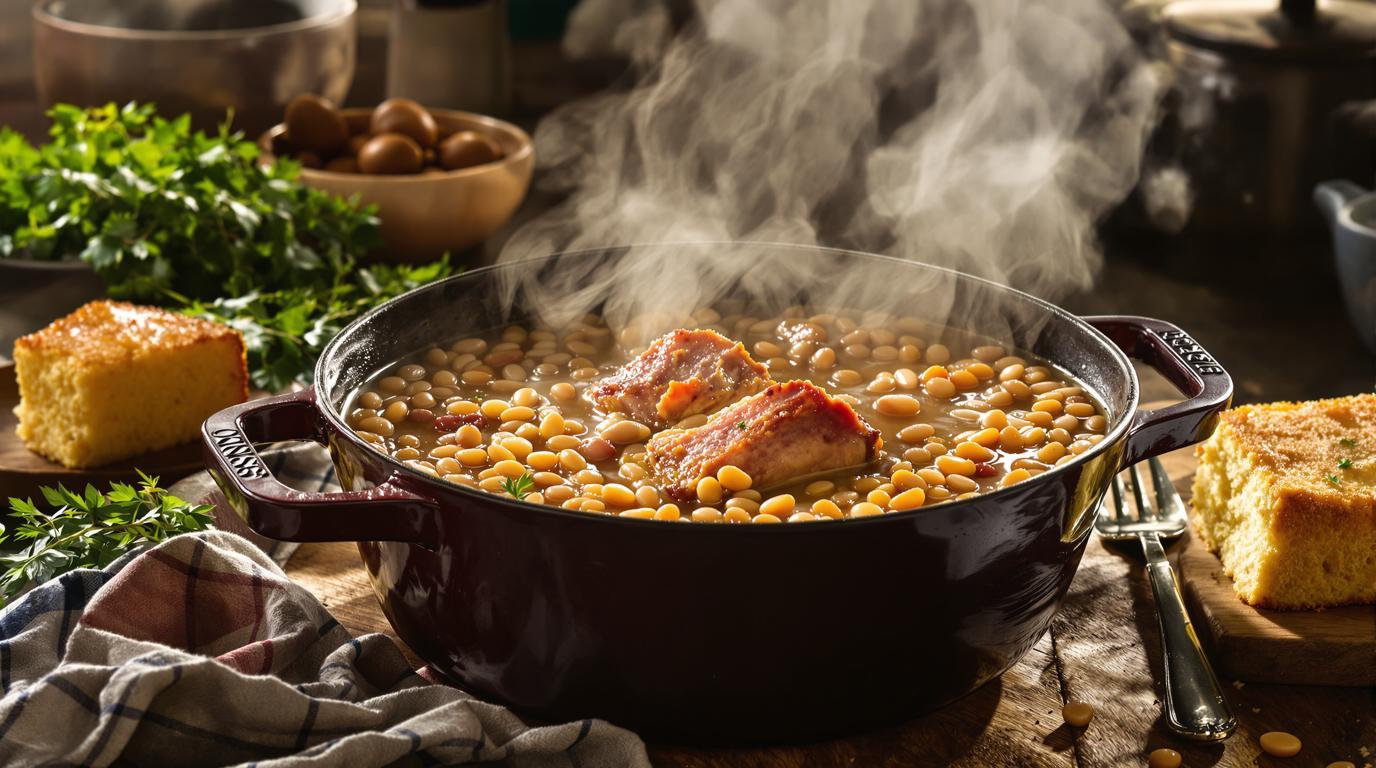The gentle rhythm of a simmering pot has always been the heartbeat of Southern kitchens. Growing up in Georgia, I watched my grandmother transform humble ingredients into something magical every Sunday afternoon. Her ham hock and beans wasn’t just a meal—it was a story of resourcefulness passed down through generations. The alchemy that happens when smoky pork meets earthy beans over low heat creates something greater than the sum of its parts. There’s a reason this dish has sustained families through both celebration and hardship for centuries.
The Soul of Southern Ham Hock & Beans 📖
Southern Ham Hock & Beans is comfort food in its purest form. This dish emerged from necessity during leaner times when rural families needed to stretch ingredients while maximizing flavor. The genius lies in how humble ingredients transform during that long, slow simmer. Navy beans are traditional in Appalachian versions, while pinto beans dominate recipes further south. What remains consistent is the essential role of smoked ham hocks—those flavorful joints that infuse everything with smoky depth.
I’ve prepared this dish in professional kitchens and for family gatherings, but it always transports me back to my grandmother’s kitchen, where the windows would fog with aromatic steam as beans softened and pork surrendered its flavor over hours of gentle heat.
The Perfect Ingredients Balance 🧾
For 6 generous servings:
- 1 pound (450g) dried navy or pinto beans
- 2-3 smoked ham hocks (about 1.5 pounds/680g)
- 1 large yellow onion, diced (about 1½ cups/240g)
- 5 garlic cloves, minced (about 2 tablespoons/15g)
- 2 celery stalks, finely diced (optional)
- 1 bay leaf (or 1 teaspoon fresh thyme)
- 8 cups (2 liters) water or chicken stock
- Freshly ground black pepper to taste
- Salt (used sparingly—ham hocks provide saltiness)
Chef’s Note: This dish exemplifies what I call “ingredient wisdom.” The beans provide hearty substance, while the ham hocks contribute three elements: smoky flavor, rich collagen that silkens the broth, and tender meat that gets folded back into the beans. It’s the epitome of whole-ingredient cooking that my culinary ancestors perfected long before “nose-to-tail” became fashionable.
Creating Bean Perfection Step-by-Step 📝
- Soak the beans: Place beans in a large bowl and cover with cold water by 3 inches. Soak overnight (8-24 hours). This step is non-negotiable—it ensures even cooking and better digestibility.
- Prepare aromatics: In a heavy-bottomed Dutch oven, heat 2 tablespoons oil over medium heat. Add diced onion and celery, cooking until translucent but not browned, about 4-5 minutes. Add garlic and cook 1 minute more until fragrant.
- Build the base: Drain and rinse the soaked beans thoroughly. Add them to the pot along with ham hocks, bay leaf, and enough water or stock to cover by 2 inches.
- Simmer properly: Bring to a gentle boil, then reduce heat to maintain a bare simmer. Partially cover and cook for 2-3 hours, checking occasionally and adding more liquid if needed.
- Finish with finesse: When beans are tender but still hold their shape, remove ham hocks. Once cool enough to handle, pull meat from bones, shred, and return to the pot. Discard bones and bay leaf. Season with black pepper and salt if needed.
The Secret Techniques That Make the Difference 🤫
The magic of this dish lies in patience and restraint. A true simmer means just a few bubbles breaking the surface—never a rolling boil which toughens beans. I’ve learned over decades that the best results come from what we don’t do: don’t rush, don’t over-salt, and don’t stir too much.
When removing the ham hocks, leave them whole until they’ve cooled slightly. This prevents the meat from drying out. The collagen-rich areas near the joints will have broken down into velvety goodness that enriches every spoonful.
If you can’t find ham hocks, smoked turkey wings offer a similar depth, while a half-pound of diced salt pork works in a pinch. Just remember that the authentic character comes from that slow-rendered smoky pork essence that only ham hocks truly deliver.
Serving With Southern Hospitality 🍽️
Ladle these beans into wide bowls with some of their rich broth. The traditional accompaniment is a wedge of skillet cornbread—crisp-edged and barely sweetened—perfect for sopping up those savory juices. A side of braised greens balances the meal with their slight bitterness.
For an elegant wine pairing that doesn’t betray the humble roots, try a robust Zinfandel that complements the smokiness. I sometimes serve these beans over steamed rice, a nod to the Cajun influence in my culinary journey, or with a side of crispy chicken thighs for a heartier Sunday supper.
The leftovers improve overnight as flavors meld, making this perfect for batch cooking. Try adding the beans to tomato sauce for a delicious twist on pasta e fagioli.
In my restaurant days, I’d occasionally dress this humble dish up with a drizzle of olive oil and fresh herbs for service, but the truth is, it needs nothing more than a spoon and appreciation for how our culinary ancestors could transform the ordinary into something extraordinary. Like any grandmother’s recipe, the real secret ingredient is time—both in cooking and in the generations of hands that shaped this dish before it reached your table.
As you savor each spoonful, remember you’re tasting more than dinner—you’re experiencing a slice of American culinary heritage, comfort by the bowlful. And if you’re feeling inspired for dessert, my silky panna cotta provides the perfect sweet ending to this soulful meal.
